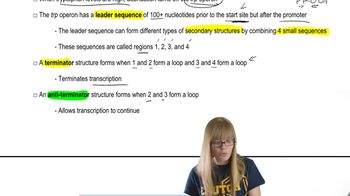Here are the essential concepts you must grasp in order to answer the question correctly.
trp Operon
The trp operon is a group of genes in bacteria that are involved in the biosynthesis of the amino acid tryptophan. It is regulated through a mechanism called attenuation, which allows the cell to respond to tryptophan levels by controlling the transcription of the operon. When tryptophan is abundant, the operon is turned off, while low levels of tryptophan lead to its activation, demonstrating a classic example of gene regulation.
Recommended video:
mRNA Leader Sequence
The leader sequence of mRNA is a short region at the beginning of the mRNA transcript that plays a crucial role in the regulation of gene expression. In the context of the trp operon, this sequence contains specific codons for tryptophan and is responsible for forming secondary structures, such as hairpins, that influence whether transcription continues or terminates. The formation of these structures is sensitive to the availability of tryptophan during translation.
Recommended video:
Hairpin Structures
Hairpin structures are formed when complementary sequences within a single strand of RNA base-pair with each other, creating a loop. In the trp operon, the formation of alternative hairpins in the leader sequence determines whether transcription will terminate or proceed. The presence of a terminator hairpin signals the RNA polymerase to stop transcription, while an antiterminator hairpin allows transcription to continue, thus playing a critical role in the regulation of gene expression.
Recommended video:




